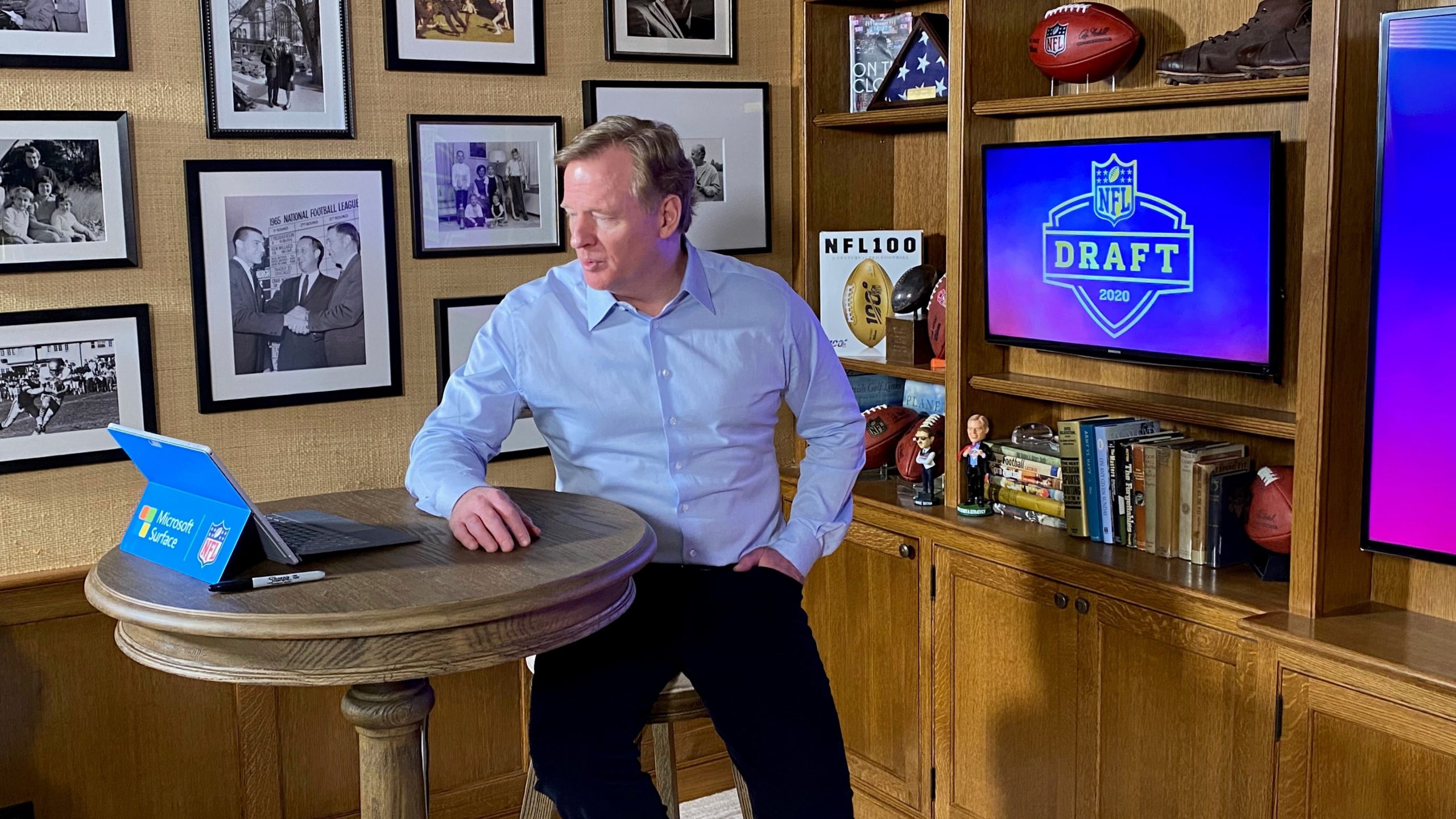
How a new game plan made the NFL Draft possible — and brought joy to fans during uncertain times
The NFL Draft could have become the latest cancellation amid the difficult realities of 2020 — until the League rewrote its playbook to save the beloved event and give sports fans a comforting diversion in a challenging time.
Held every year since 1936, the massively popular communal sports experience typically unfolds with all the spectacle of an awards show, and it attracts more viewers than most other major sports’ playoff games. With nothing on the sports calendar for the foreseeable future, if the NFL could pull off their draft, it would bring millions of Americans together to experience an unforgettable moment in League history — while offering fans a desperately needed moment of distraction.
Microsoft was in a unique position to help. Since 2013, the company has teamed with the NFL to transform their technology both on-field and off. It had become commonplace to see coaches coordinating plays using Surface devices, referees scrutinizing replays via Microsoft Surface Instant Replay and the sport’s 32 clubs handling draft prep, coordinating with offsite scouts, managing shared calendars and even planning the Super Bowl via Microsoft Teams.
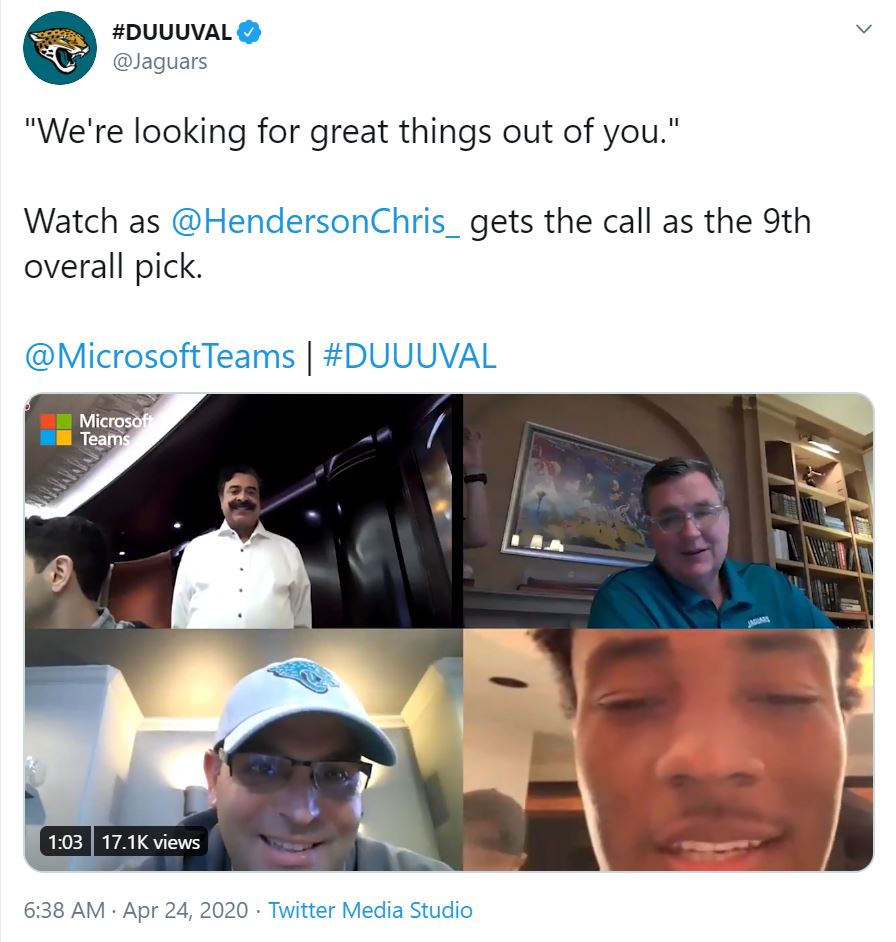 “Microsoft and the NFL have had a long-standing partnership focused on using technology innovation to improve the game for fans, players and coaches, and Surface has become an integral part of play-calling, instant replay and NFL club operations,” says Yusuf Mehdi, Microsoft’s corporate vice president of Modern Life, Search and Devices. “We’re delighted to take another step forward in the partnership with Microsoft Teams — it was the ideal solution to ensure the NFL had the technology they needed to bring the first-ever virtual NFL Draft to life.”
“Microsoft and the NFL have had a long-standing partnership focused on using technology innovation to improve the game for fans, players and coaches, and Surface has become an integral part of play-calling, instant replay and NFL club operations,” says Yusuf Mehdi, Microsoft’s corporate vice president of Modern Life, Search and Devices. “We’re delighted to take another step forward in the partnership with Microsoft Teams — it was the ideal solution to ensure the NFL had the technology they needed to bring the first-ever virtual NFL Draft to life.”
Microsoft’s partnership with the NFL is “based on a strategy that’s core to everything we do, that we bring product authenticity, truth and integration into companies that helps them achieve more,” explains James Bernstrom, product marketing director for Microsoft. “When the world began to change, the NFL needed us to architect a new solution.”
As the novel coronavirus swept the nation in mid-March and phrases like “stay at home” and “flatten the curve” became the new normal, NFL Commissioner Roger Goodell was forced to cancel plans for an elaborate draft on the Las Vegas Strip. Rather than a massive stage at the new Caesars Forum, he would need to announce picks from his basement in Bronxville, N.Y.; rather than a red carpet in front of the Bellagio fountains, players would be sitting on their sofas.
Each of the 32 teams would have massive stakes and the pressure of a ticking clock riding on every pick — but instead of being within arm’s reach of League personnel, they would be selecting the future cornerstones of their franchise in disparate homes, offices and bonus rooms across the country, including at least one owner who planned to draft from his luxury yacht.
“It was the ideal solution to ensure the NFL had the technology they needed to bring the first-ever virtual NFL Draft to life.”
“Once it became clear that COVID-19 was going to force the NFL’s first-ever virtual draft, we proposed using Teams,” says Jeff Teper, Microsoft Teams corporate vice president. “But we knew that if we were going to get all these stakeholders on the same page technologically, address potential security issues and have it all go smoothly on live TV, it would require a very detailed plan.”
Adds Bernstrom: “Custom testing, custom development — we just didn’t have the runway to go and do that. The NFL had a challenge to accurately, securely and quickly capture who the draft picks were, and Teams had the features we needed to put together a solution.”
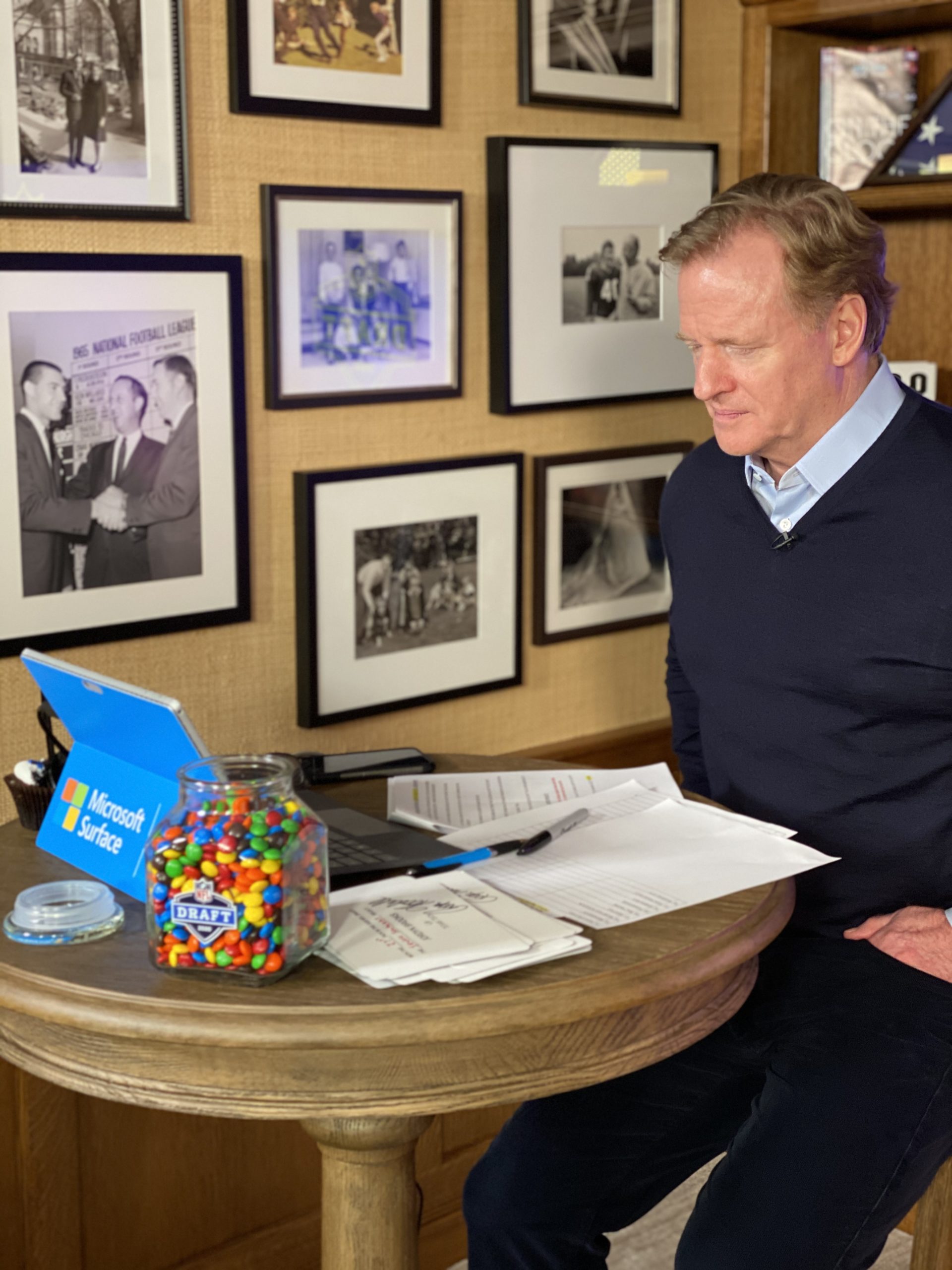
NFL Commissioner Roger Goodell waits for the next draft pick to come in while at his home during the 2020 NFL Draft. (Photo courtesy of the NFL)
A game plan was drawn up to create 32 separate private Teams channels within the NFL’s organization, for each NFL club to join as guests. Each club would be able to communicate and collaborate within their own ranks and with the NFL in this private channel, without being afforded visibility into the other clubs’ activities.
Each club would be given access to a form, where they could fill in the draftee’s name, college and other information. If the team “on the clock” submitted incorrect information, the club’s private channel would be notified of the error; if everything was in order, the NFL would authenticate the pick, then a Microsoft tool called Power Automate would automatically post it on the private “Head Table” channel and simultaneously relay it to Commissioner Goodell’s Surface tablet so the pick could be transferred to the paper card and announced on-air.
“One of the key elements of this solution was it had to be very simple,” says Bernstrom, who spent the ensuing weeks with a team of people from Microsoft and the NFL organizing multiple dry-runs and a full-on mock draft with over 100 participants. “These people are in their homes using technology to communicate in real-time during a live event. So it had to be very simple, because there was a wide variety of technological experience among the users. That was a huge factor.”
“In a situation like this, you’re dealing with people’s laptops, their home network bandwidth, you’ve got to get all those kinks worked out,” adds Teper. “Thankfully, Teams is a very flexible collaborative tool — so, rather than using channels for marketing, sales and HR like some companies might, we set them up for each club. It was a coming together of Microsoft Teams as the shell, private channels for security, Forms for a simple way to submit the picks, and Power Automate to make sure all this routing is enforced.”
Minnesota Vikings’ football information systems director Paul Nelson says the weeks before the draft reminded NFL teams of a lesson they know all too well: Practice breeds familiarity, which breeds the confidence needed to excel under pressure.
“We did mock drafts and training on the use of Teams,” remembers Nelson. “We would mock with a smaller group, identify potential issues, work on mitigating those issues and then run a mock with the entire group. By going through those mock drafts, we were able to simplify how we’d run our virtual draft.”
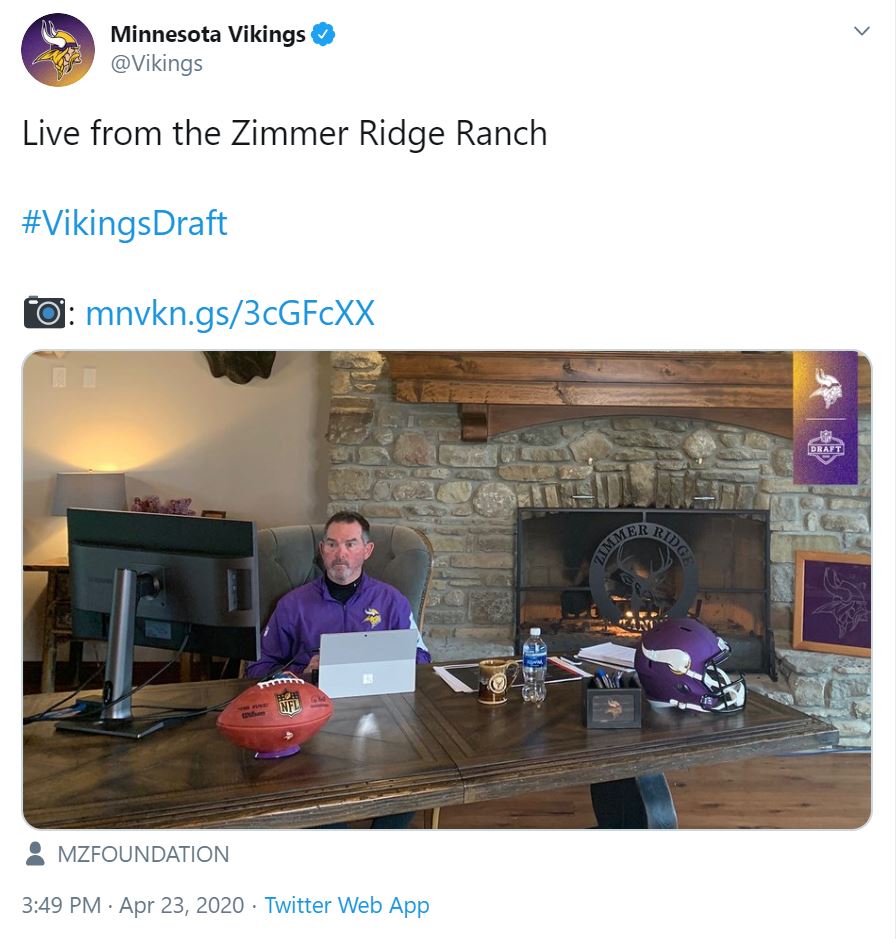 Kevin Higgins, director of IT for the Kansas City Chiefs, recalls a similar method for getting everyone on the same page. “We set up several ‘rooms’ in Teams to mimic the scenario including ‘Draft,’ ‘Coaching,’ ‘Scouting’ and ‘Medical.’ To ensure everyone was comfortable with the technology, we held several mock drafts prior to the real one.”
Kevin Higgins, director of IT for the Kansas City Chiefs, recalls a similar method for getting everyone on the same page. “We set up several ‘rooms’ in Teams to mimic the scenario including ‘Draft,’ ‘Coaching,’ ‘Scouting’ and ‘Medical.’ To ensure everyone was comfortable with the technology, we held several mock drafts prior to the real one.”
For the Jaguars (who would tie a franchise record with 12 picks this year), intensive draft practices became the front office equivalent of two-a-days.
“Familiarization with Teams began early on, through weekly organization-wide meetings featuring guest speakers, employee gatherings and virtual events,” says the Jaguars’ vice president of technology, Mike Webb. “We created a team inside Teams to store all draft setup diagrams and quickly collaborate for planning infrastructure at the homes of our head coach and general manager. When the week of the draft arrived, we ran tests daily.”
But, as any offensive coordinator will tell you, calling the right play in the huddle doesn’t always guarantee success. What if an on-the-clock coach has Wi-Fi issues? What if a hacker gets in? What if a photogenic dog finds an inopportune moment to put his paw on the “enter” key? As the sport’s first virtual draft kicked off — and a record-setting average of 15.6 million viewers tuned in — the blitz was on.
With the first overall pick, the Cincinnati Bengals select 23-year-old quarterback Joe Burrow of LSU. Everything works as intended; Commissioner Goodell makes the announcement. Microsoft’s Teper watches it all unfold from his office, jumping intently between four open windows on his screen.
“I’ve got my Outlook, I’ve got Twitter and ESPN, and then our Teams group tracking how everything’s going behind the scenes,” Teper says of draft time. “Our team is from all over, so a lot of us are excited on multiple fronts; we have an insane Jets fan, and he’s proudly wearing his jersey.”
“The fact that we were virtual became a non-issue.”
One pick after another sails past; none of the evening’s adrenaline seems to be lost, and the novelty of peeking into everyone’s disparate homes — with draft picks having their lives changed while surrounded by loved ones in sweatpants — only adds to the thrill. Many clubs use Teams to arrange “welcome to the show” video conference calls to introduce themselves to their newly picked players. When the evening is over, everything is deemed a success, and the headlines are focused exactly where they should be: on the teams, not the tech.
“We were all celebrating, sending each other emojis, videos and virtual high fives,” Teper says of the backstage vibe in the wee hours of the morning. “We’re a passionate, competitive team that likes to help our customers. So we felt a little bit like players on the field, down there with the teams helping them get stronger.”
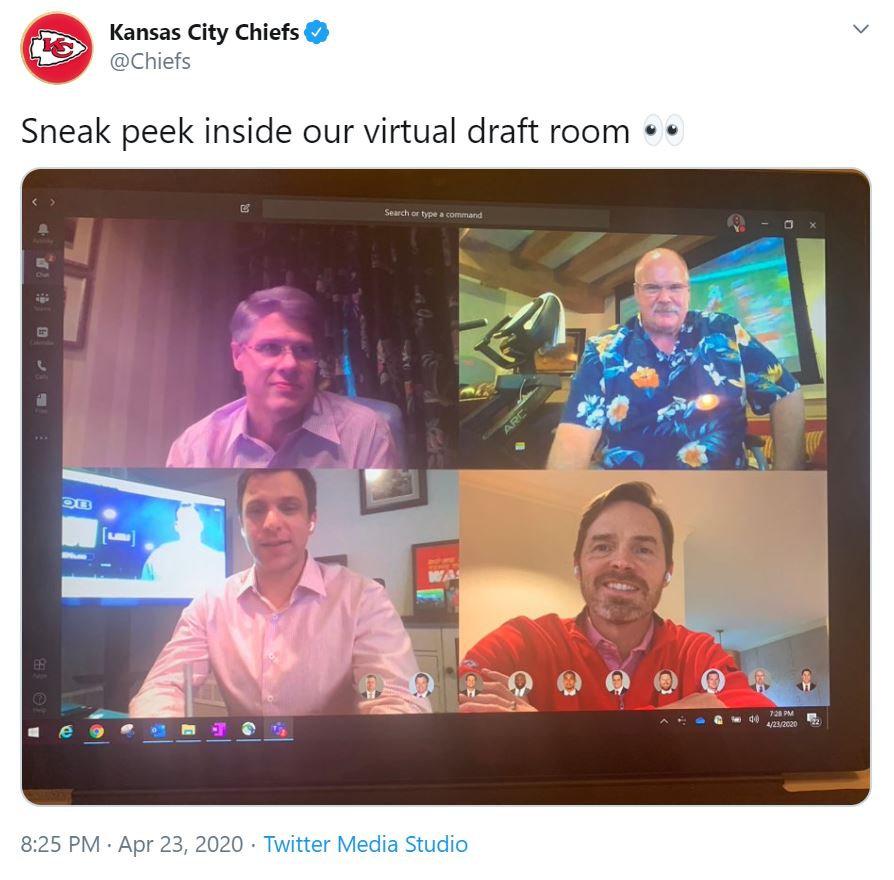 “The clubs had not only successfully used Teams to record and announce their draft picks, but we used Teams behind the scenes to help them get it done,” says Bernstrom. “We had used collaborative tools like screen sharing to look at their tenant as they were building it all out; we had experts on the Microsoft side in close coordination across multiple private channels, recording sessions so people who couldn’t be there could hear them afterwards. So Teams not only powered the most critical element of the NFL Draft, but also made it possible.”
“The clubs had not only successfully used Teams to record and announce their draft picks, but we used Teams behind the scenes to help them get it done,” says Bernstrom. “We had used collaborative tools like screen sharing to look at their tenant as they were building it all out; we had experts on the Microsoft side in close coordination across multiple private channels, recording sessions so people who couldn’t be there could hear them afterwards. So Teams not only powered the most critical element of the NFL Draft, but also made it possible.”
Subsequent nights of the draft proved to be equally successful. Instead of traditional war rooms, each club had their people participating from across the country; instead of a rep writing a name on a physical card to be run up to the head table, everything was virtual and went down faster than Henry Ruggs III at the Combine.
“The NFL has a problem with this draft format: it’s better than the old way,” Los Angeles Times reporter Sam Farmer said in his analysis.
“Truthfully, there were times the draft was so smooth, I stopped paying attention,” wrote Jason Gay in The Wall Street Journal. “Did the NFL pull it off? Yes, they pulled it off.”
Judging by comments from the Vikings’ Nelson, even when things go back to normal, the sport’s first virtual draft may have changed things forever: “There are several things we learned. Virtual meetings will be something we can use going forward to potentially reduce travel costs; we were forced to reevaluate how we prepare for the draft, and were able to develop some technology driven solutions to streamline the preparation process; we’re looking at using Teams for our college scouting applications going forward. The success we’ve had — and the comfort level people have developed — will make future integration easier.”
“Now that Teams has taken the place of our traditional draft room phone call,” echoes the Jaguars’ Webb, “we might continue using that face-to-face interaction to greet our new picks and welcome them to the Jaguars.”
Adds the Chiefs’ Higgins: “The fact that we were virtual became a non-issue.”
Did all this effort to make draft day happen defeat the invading opposition? Not by a long shot. But these days, it sure is nice to see a victory for the home team.
Lead photo: NFL Commissioner Roger Goodell prepares to announce draft picks from his home on April 23, 2020. (Photo courtesy of the NFL)
